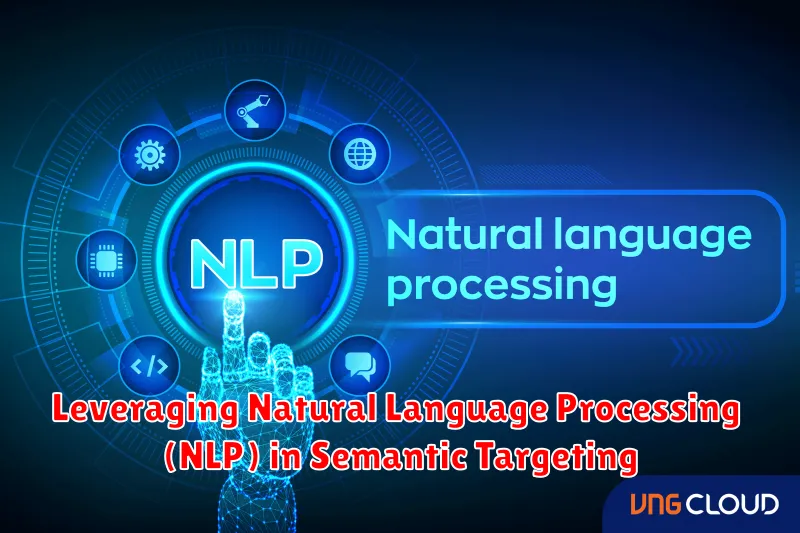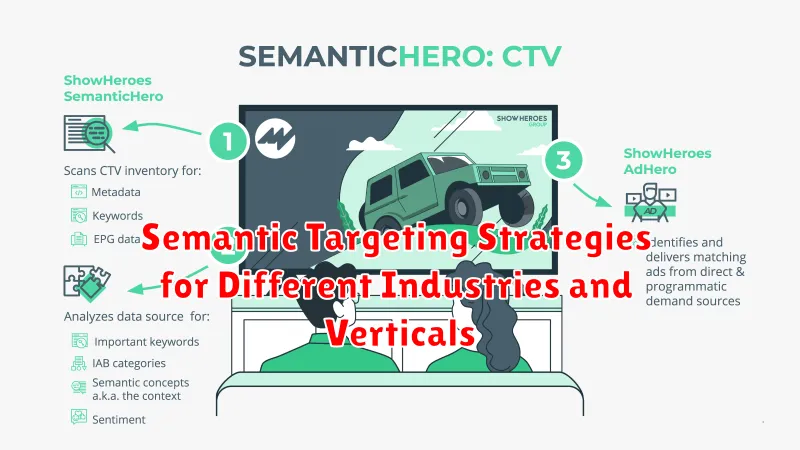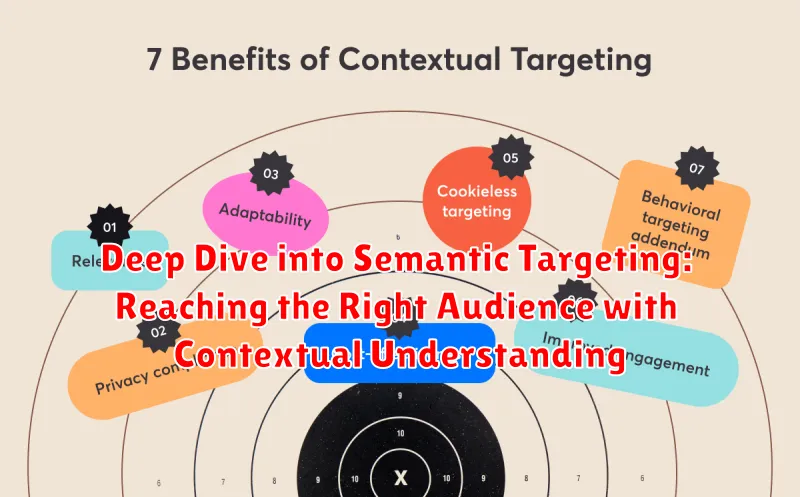In today’s dynamic digital advertising landscape, reaching the right audience is paramount for campaign success. Traditional targeting methods, while offering some level of precision, often fall short in connecting with users based on their real-time interests and needs. This is where semantic targeting emerges as a powerful solution. This article, “Deep Dive into Semantic Targeting: Reaching the Right Audience with Contextual Understanding,” provides a comprehensive exploration of this advanced targeting technique, illustrating how it leverages contextual understanding to deliver highly relevant ads to users immersed in related content. By moving beyond simple keyword matching, semantic targeting analyzes the meaning and intent behind online content, ensuring your message resonates with a truly engaged audience.
This exploration into semantic targeting will unpack its core principles, demonstrating how it differs from and surpasses traditional keyword-based strategies. We’ll delve into the technological underpinnings that enable contextual analysis and audience segmentation based on nuanced semantic understanding. Furthermore, we’ll examine real-world case studies and practical applications, showcasing the measurable benefits of employing semantic targeting across various industries. From enhancing brand awareness to driving conversions, understanding and implementing semantic targeting can be a game-changer for any marketing strategy aiming for increased efficiency and impact. Join us as we uncover the potential of connecting with your ideal customer through the power of contextual relevance.
What is Semantic Targeting and How Does It Work?
Semantic targeting is an advanced advertising technique that focuses on understanding the meaning and context of online content to deliver relevant ads. Unlike keyword targeting, which relies solely on the presence of specific words, semantic targeting analyzes the overall theme and sentiment of a webpage or article.
How it works:
- Content Analysis: The system uses Natural Language Processing (NLP) to analyze the text and identify the main topics and concepts.
- Contextual Understanding: It goes beyond simple keyword matching to grasp the intent and relationships between words.
- Ad Matching: Ads are then matched to content based on this deeper understanding, ensuring relevance to the user’s current reading or browsing experience.
This approach allows advertisers to reach audiences interested in a particular subject matter, even if the specific keywords are not explicitly mentioned.
Semantic Targeting vs. Keyword Targeting: Understanding the Key Differences
While both semantic targeting and keyword targeting aim to connect advertisers with the right audience, they employ fundamentally different approaches. Keyword targeting focuses on matching ads with specific words or phrases that users search for or that appear on web pages.
In contrast, semantic targeting analyzes the context and meaning of content, going beyond simple keyword matching. It leverages Natural Language Processing (NLP) to understand the overall theme and sentiment of a page, ensuring ads are relevant even if the page doesn’t contain the exact keywords targeted. For example, an ad for running shoes might appear on an article about marathon training, even if the word “shoes” isn’t explicitly mentioned frequently.
Here’s a simple breakdown:
- Keyword Targeting: Relies on specific words.
- Semantic Targeting: Understands the context and meaning.
Therefore, semantic targeting is more about the “what” of the content, whereas keyword targeting is more about the “which” of the content. The former offers a potentially broader and more accurate reach.
The Benefits of Semantic Targeting for Advertisers
Semantic targeting offers a multitude of advantages for advertisers seeking to optimize their campaigns and achieve superior results. By moving beyond simple keyword matching, advertisers can connect with audiences based on the contextual meaning of the content they are consuming.
One key benefit is improved ad relevance. Semantic targeting ensures that ads are displayed alongside content that is genuinely relevant to the user’s interests and needs, leading to higher engagement and click-through rates. This relevance translates to better ROI on advertising spend.
Another advantage is enhanced brand safety. By understanding the nuances of language and sentiment, semantic targeting can help advertisers avoid placing ads on pages with negative or inappropriate content, protecting brand reputation and integrity.
Furthermore, semantic targeting allows advertisers to reach a wider audience. It identifies and targets users who are interested in a topic, even if they don’t explicitly use specific keywords, thereby expanding the reach of the advertising campaign.
How Semantic Targeting Enhances Ad Relevance and User Experience
Semantic targeting significantly improves ad relevance by ensuring that advertisements are displayed in contexts directly related to their subject matter. This contextual alignment leads to a more positive user experience.
Traditional keyword targeting often relies on exact or broad match keywords, which can result in ads appearing on pages with only a superficial connection to the advertised product or service. Semantic targeting, conversely, analyzes the overall meaning and intent of a webpage, allowing for a deeper understanding of the content and enabling the placement of ads that genuinely resonate with the user’s interests and needs.
By delivering ads that are more relevant, semantic targeting reduces the likelihood of banner blindness and increases the probability of user engagement. This, in turn, can lead to higher click-through rates (CTRs) and improved conversion rates, ultimately benefiting both the advertiser and the user.
Leveraging Natural Language Processing (NLP) in Semantic Targeting

Natural Language Processing (NLP) is pivotal in semantic targeting, enabling algorithms to understand the meaning and context of online content with greater accuracy. Unlike keyword-based approaches, NLP allows for the identification of subtle nuances, sentiment, and intent within text.
How NLP Powers Semantic Analysis
NLP techniques like entity recognition, sentiment analysis, and topic modeling are crucial. These processes allow the system to discern the central themes, entities involved, and overall sentiment of web pages and articles. This in-depth understanding allows advertisers to target users based on the contextual relevance of the content they are engaging with.
Benefits of NLP-Driven Semantic Targeting
The integration of NLP significantly improves the precision of ad targeting. By interpreting the semantic meaning behind content, ads are more likely to resonate with users, leading to higher engagement and conversion rates. This also minimizes the risk of ads appearing in inappropriate or irrelevant contexts.
Best Practices for Implementing Semantic Targeting in Your Campaigns
To maximize the effectiveness of semantic targeting in advertising campaigns, consider these best practices:
- Define Clear Campaign Goals: Establish specific objectives, such as brand awareness, lead generation, or conversions, to guide your semantic targeting strategy.
- Conduct Thorough Content Analysis: Analyze the content landscape relevant to your target audience to identify key themes and topics.
- Refine Semantic Categories: Regularly review and refine semantic categories to ensure they accurately reflect user interests and content relevance.
- Leverage Negative Keywords: Implement negative keywords to exclude irrelevant content and improve ad precision.
- Monitor Performance Metrics: Track key performance indicators (KPIs) such as click-through rates (CTR), conversion rates, and return on ad spend (ROAS) to optimize campaigns.
- A/B Test Different Strategies: Experiment with various semantic targeting approaches to identify the most effective combinations for your specific campaign goals.
- Ensure Brand Safety: Implement brand safety measures to avoid associating your ads with inappropriate or harmful content.
The Role of Contextual Data in Semantic Targeting
Contextual data is paramount in semantic targeting, providing the necessary information to understand the meaning and intent behind online content. This data goes beyond simple keywords, encompassing various elements that define the context of a webpage or article.
Key components of contextual data include:
- Topic Categorization: Understanding the broad subject matter of the content.
- Sentiment Analysis: Determining the emotional tone (positive, negative, neutral) of the text.
- Entity Recognition: Identifying and classifying key entities like people, places, and organizations mentioned in the content.
- Keyword Extraction: Pinpointing the most relevant keywords and phrases.
By analyzing this contextual data, semantic targeting platforms can accurately determine the relevance of an ad to the content being viewed. This ensures that ads are displayed in environments where they are most likely to resonate with the target audience, leading to improved ad performance and a more positive user experience.
Measuring the Effectiveness of Semantic Targeting: Key Metrics and KPIs
Evaluating the success of semantic targeting campaigns requires a focus on specific metrics and Key Performance Indicators (KPIs). Unlike traditional keyword-based approaches, semantic targeting emphasizes understanding the context of content, necessitating a shift in how we measure effectiveness.
Key Metrics to Monitor
- Click-Through Rate (CTR): Indicates the percentage of users who click on your ads after seeing them within relevant content.
- Conversion Rate: Measures the percentage of users who complete a desired action (e.g., purchase, sign-up) after clicking on an ad.
- Engagement Metrics: Track metrics like time spent on page, bounce rate, and pages per session to assess user engagement with your landing pages after clicking on an ad.
- Cost Per Acquisition (CPA): Calculates the cost of acquiring a new customer through your semantic targeting campaigns.
- Return on Ad Spend (ROAS): Measures the revenue generated for every dollar spent on advertising.
By closely monitoring these metrics, advertisers can gain valuable insights into the performance of their semantic targeting campaigns and optimize them for better results.
Semantic Targeting Strategies for Different Industries and Verticals

Semantic targeting allows for tailored strategies across diverse sectors. The approach to implementation varies significantly based on industry-specific content and consumer behavior. Here are a few examples:
- Finance: Focus on articles discussing market trends, investment strategies, and economic analysis. Target users showing interest in financial planning and investment opportunities.
- Healthcare: Target content related to specific medical conditions, treatment options, and wellness advice. Deliver ads for relevant pharmaceuticals, health services, or medical devices.
- Automotive: Target articles discussing car reviews, maintenance tips, and new technologies. Show ads for specific car models, parts, or services.
- E-commerce: Align ads with content discussing product reviews, buying guides, and style trends. Promote relevant product categories based on the context of the article.
The key is to understand the nuances of each industry and adapt the semantic targeting strategy accordingly. Relevance is paramount for successful ad delivery.
The Future of Semantic Targeting: Emerging Trends and Technologies
The future of semantic targeting is poised for significant advancement, driven by emerging trends and technologies. One key trend is the increasing sophistication of Natural Language Processing (NLP), allowing for a deeper and more nuanced understanding of content. This enables more accurate contextual analysis and improved ad placement.
Another trend is the growing importance of AI and Machine Learning (ML). ML algorithms are being used to continuously learn and adapt, improving the precision of semantic targeting over time. This leads to better identification of relevant content and more effective ad delivery.
Furthermore, the development of more granular contextual data sources is enhancing semantic targeting capabilities. Access to richer data allows advertisers to target specific audiences based on a more comprehensive understanding of their interests and behaviors. Expect to see increased focus on privacy-centric approaches to data collection and utilization.

